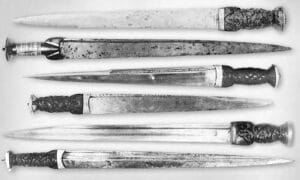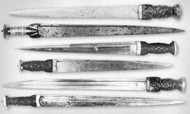Scottish Dirks
Posted by Charles MacGregor on Feb 10th 2019
Originally published April 2013. Written for The Celtic Croft by Charles MacGregor of MacGregor Historic Games.
Scottish Dirks
We have a guest writer this month. A friend, Joseph D. Smith shared with me an article along he wrote some time ago along with a couple illustrations. His knowledge on the topic comes from not just book research, but also from some personal experience hand-forging dirks and other knives.
Origin, Development and Decline of the Scottish Dirk
The dirk was not just a tool to the Highlanders, but also a cultural artifact. For instance, "when a group of men wanted to bind themselves to some desperate venture, they swore on a dirk, and the penalty for breaking the oath was to be stabbed with the dirk" -The Highland Dirk, by James W Everett, 1987.
In the beginning was the ballock knife. The earliest ballock knives from the 1300's had large wooden knobs at the base of the hilt, making them somewhat phallic in appearance. However, the knobs served a purpose. They kept the wielder's hand from slipping onto the blade since these knives did not have metal cross guards. Early ballock knives usually had single-edged blades of a triangular profile. By 1400 double-edged triangular blades were more common and by 1450 thick, narrow, armor piercing blades were widely preferred.
Right: Ballock knives based on examples found on Henry VIII's ship the Mary Rose.

In England and Scotland, the wood or root of the box-tree (Buxus species) was often used for hilts. The wood is hard, fine grained and white; the root is gnarly and split-resistant and turns black on long exposure to air. It is also called "dudgeon-root", and "dudgeon dagger is an English term for a ballock knife. In Scotland, ballock knives were sometimes also called dirks before the knife we now call a dirk appeared.
In spite of their simplicity, the early ballock knives were apparently commonly carried by knights. As the Middle Ages ground on, fancier and fancier ballock knives appeared for wealthy men. Plain wooden ones were still made for poorer folk, and in the 14th and 15th centuries, these knives were very common. In the 15th century the knobs on the knives lost their round shape and began to curve downward beside the blade. It became common to fit a curved metal plate to the bottom of the hilt, and decorative metal pommel caps began to come in as well. Further, the shape of the handle changed. One fashionable form flared out from the knobs into a large ribbed, trumpet-shaped cone. Another popular grip was straight sided, but octagonal, fluted or both.

The ballock knife drifted out of favor in continental Europe by the mid 1500's, largely replaced by the quillion (cross-guard) dagger. In England and Scotland, a conservative form continued to be used past 1600. On this style of knife, the knobs had evolved into a more or less flat, semicircular section between the grip and blade.
The dirk proper seems to have evolved from the late ballock knife, probably around the mid 1600's. It differs from the late ballock knife mostly in having the semicircular section divided down the middle into a pair of "haunches", and by the top of the hilt flaring abruptly into a short, wide, flat-topped cone. The early dirks had wooden handles. The grip was usually thin, short and cigar shaped, often carved with bands of Celtic knot-work in high relief. They almost always had brass plate on the pommel end, but not always on the blade end of the hilt. The tang of the blade passed completely through the hilt and the pommel plate, and was usually secured by a small decorative brass nut. On a few early dirks, the tang is split and peened (hammered) over.
Early dirks had a single-edged blade of roughly triangular profile; the edges of the blade were often nearly straight. Blades were usually thick at the base, 1/4 inch or more, and tapered in both thickness and width. Most were about 10" to 14" inches long. Many, but not all, have single deep, narrow fuller (groove) near the back. Some are decorated with file work on a brass strip on the back of the blade. This brass strip is also seen on 19th century American Bowie knives. It was theoretically supposed to catch the edge of an enemy's knife. Its presence on dirks suggests they may have been used for sophisticated knife-fighting, rather than merely downward stabbing as many authors believe. Then again, its function could be merely decorative. The authors do not mention whether the brass on surviving specimens is hacked or gouged from parrying, as it is on some surviving Bowie knives.
In the late 17th or early 18th century, brass handles became fairly common, and pewter ones were seen occasionally. On brass hilts the tang passed completely through as on wooden hilts. On pewter hilts, the hilt was sometimes just pounded on. By this time some wooden hilts were completely covered with carving, including the haunches. The pommel plate became a cap that came down to protect the thin edges of the pommel. Likewise, metal caps appeared to protect the edges of the "haunches".
During the 18th century there were two trends in blade design. One was the greater use of broken, or cut down sword blades. These usually had a long, sharpened "false edge" that met the main edge at a slight angle to form a long, narrow, double edged point. These were longer than 17th century dirks, with 15 inches of length, or even more. Many Scots probably carried these extra-long dirks as short swords, in place of the heavy, expensive basket-hilted broadswords favored by the chiefs and lairds. These peasant dirk/swords are mentioned in 18th century documents, but unlike the fancy dirks of gentlemen, none seem to have survived the centuries.
The other change was a tendency for the edge and back of the blade to become more curved, resulting in a blade shaped like a longer and narrower version of a "French chef's knife." Having made a few dirks, I suspect the reason was practical. A blade with slightly curved edges is easier to forge, less likely to warp or crack when quenched to harden, and stronger at the tip. It also makes slicing cuts better than a straight edge.
By about 1790 the works of Sir Walter Scott became popular, portraying the Highlanders as romantic noble savages. With many of the Jacobites safely dead, or "transported" it became fashionable for the idle nobility to play at being Highlanders. But during the years following disarming acts following the failed '45 Rebellion the form of the dirk degenerated into handles with a bulbous "baluster" shape. They were covered with shallow basket work carvings instead of elegant knot work in high relief. Hilts were often ebony instead of box root. Fittings were silver rather than practical brass or iron.
By the early 1800's it became fashionable to mount a "cairngorm" (yellow smoky quartz native to Scotland) stone on the top of the pommel, and later to tilt the pommel to show off the stone. The dirk had became pretty much a costume piece rather than a tool or weapon.

